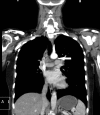A rare manifestation of a multisystemic disease: a case of vocal cord palsy secondary to sarcoidosis
- PMID: 25917073
- PMCID: PMC4422924
- DOI: 10.1136/bcr-2015-209728
A rare manifestation of a multisystemic disease: a case of vocal cord palsy secondary to sarcoidosis
Abstract
We describe a rare case of recurrent laryngeal nerve neuritis secondary to sarcoidosis. A 40-year-old woman presented with persistent dysphonia. This was her first episode of dysphonia with no reports of laryngeal trauma. Fibre-optic laryngoscopy revealed a normal nasal passage, nasopharynx and pharynx. The supraglottic structures were all unremarkable; however, inspection of the true vocal cords revealed a left vocal cord palsy that was identified as being in a paramedian position. Radiological investigation showed mediastinal adenopathy that measured up to 20 mm in the short axis diameter. Histological examination showed granulomatous lymphadenitis of the lymph node with a central area of sclerosis surrounded by discrete, non-caseating granuloma. Stains for acid-fast bacilli were negative. The morphological features were suggestive of sarcoidosis. The lymphadenopathy distribution and size did not suggest left recurrent laryngeal nerve compression, giving a subsequent diagnosis of recurrent laryngeal nerve neuritis secondary to sarcoidosis.
2015 BMJ Publishing Group Ltd.
Figures


References
-
- Olweny CL. Cotswolds modification of the Ann Arbor staging system for Hodgkin's disease. J Clin Oncol 1990;8:1598. - PubMed
Publication types
MeSH terms
LinkOut - more resources
Full Text Sources
Other Literature Sources
Medical
